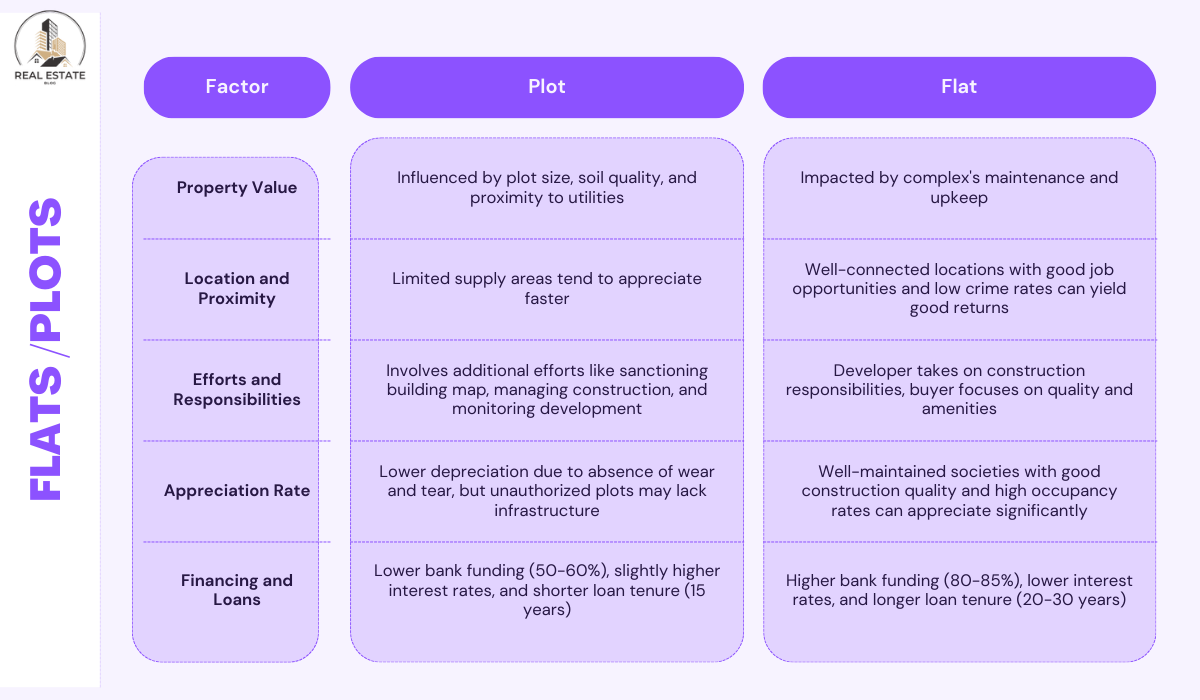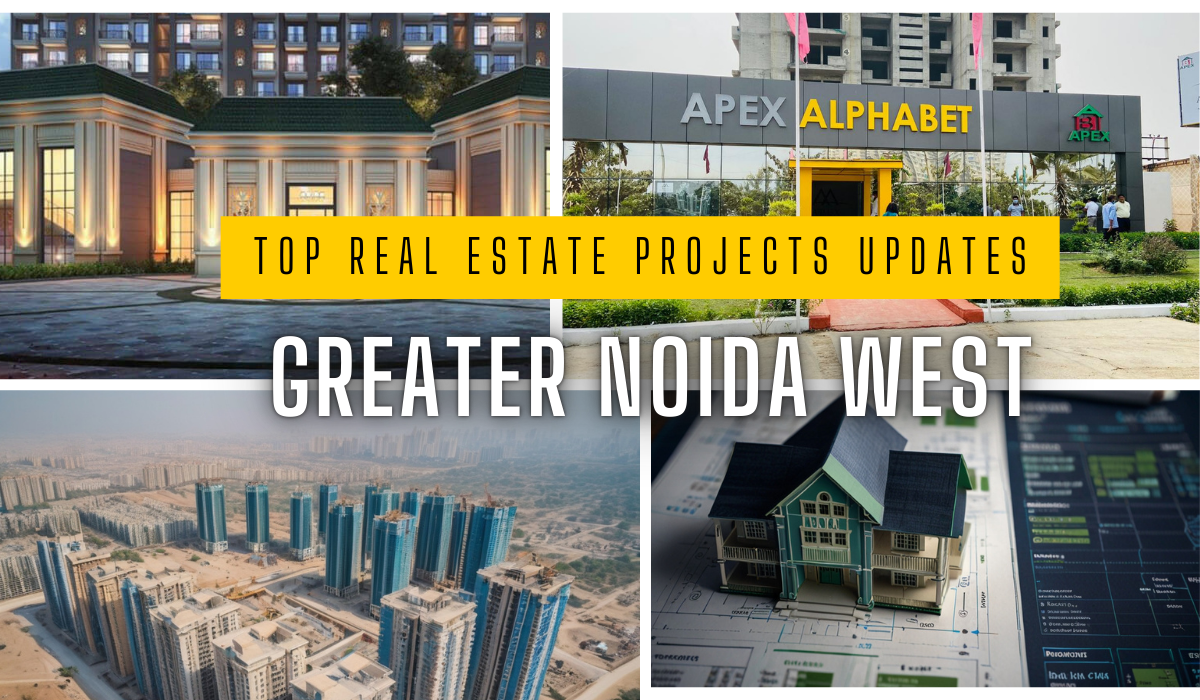When it comes to investing in real estate, one of the crucial decisions you’ll face is whether to opt for a plot or a flat. Both options have their own advantages and considerations, and the choice ultimately depends on your personal needs, lifestyle, finances, and long-term objectives. In this article, we’ll explore the key differences between plots and flats, helping you make an informed decision.
Property Value Appreciation:
- Both plots and flats tend to appreciate in value over time, largely influenced by factors such as connectivity, road infrastructure, transportation, metro lines, and overall development in the area.
- When considering a plot, pay attention to the plot size, soil quality, and proximity to utilities.
- For flats, the property value is impacted by the complex’s maintenance and upkeep.
Maintenance Costs:
- Flats typically incur higher maintenance costs compared to plots.
- In metropolitan cities, the maintenance charge for flats is around 3.5-4 rupees per square foot, which is charged by the developer until society handover to the Resident Welfare Association (RWA).
- Plot maintenance is relatively lower, ranging from 10 to 20 rupees per square yard, depending on the developer and amenities provided.
Car Parking:
- In flats, car parking is often charged separately, with costs ranging from 3 to 6 lakh rupees in metropolitan cities, which can be a significant additional expense if you own multiple vehicles.
- Plots offer more flexibility in terms of parking, as you can easily accommodate parking spaces on the ground floor or in a stilt area without incurring extra costs.
Vastu and Orientation:
- When buying a plot, people generally prefer north or east-facing plots, as they are believed to offer better appreciation.
- In flats, achieving perfect vastu compliance for every room or apartment is not always possible due to the group housing structure.
- Park-facing flats are often in higher demand compared to other orientations.
Location and Proximity:
- The choice between a plot and a flat often depends on the location and proximity to your workplace, social infrastructure, and amenities.
- Plots in limited supply areas tend to appreciate faster due to the demand-supply dynamics.
- Flats in well-connected locations with good job opportunities and low crime rates can also yield good returns.
Efforts and Responsibilities:
- Buying a plot involves additional efforts such as sanctioning the building map, hiring architects and contractors, managing construction materials, and monitoring the day-to-day development.
- In flats, the developer takes on the construction responsibilities, leaving you to focus on the construction quality and amenities provided.
- Plotted colonies may require more travel time to access amenities like clubhouses and swimming pools due to the spread-out nature of the development.
Appreciation Rate and ROI:
- It is a common misconception that plots always appreciate faster than flats. In reality, both can provide good returns depending on the location, demand-supply dynamics, and property management.
- Plots have an advantage in terms of lower depreciation due to the absence of wear and tear, but unauthorized plots can remain undeveloped for a long time and lack necessary infrastructure.
- Flats in well-maintained societies with good construction quality, amenities, and high occupancy rates can also appreciate significantly.
Modification and Customization:
- Plots offer greater freedom in terms of design and customization, subject to building plan approvals from the urban local body.
- In flats, the scope for modification is limited due to the pre-designed structure and load-bearing considerations.
Rental Income Potential:
- Plots do not generate immediate rental income until construction is completed, except for occasional storage purposes.
- Flats, on the other hand, can be leased or rented out immediately, especially in areas with good job opportunities.
Possession Timelines:
- Flats usually have a possession timeline of 3-5 years due to the construction process, with some developers now extending it to 6-7 years for safety and compliance reasons.
- Plotted colonies, if not too large, often offer possession within a year or a year and a half, allowing for faster access to the property.
Financing and Loans:
- Banks typically provide higher loan amounts for flats, ranging from 80 to 85 percent of the property value, including interior loans.
- For plots, bank funding is comparatively lower, around 50-60 percent of the plot value plus construction costs.
- Loan interest rates are slightly higher for plots compared to flats, and the loan tenure is generally shorter (15 years for plots vs. 20-30 years for flats).
Tax Benefits:
- Flats offer tax benefits through monthly loan repayments, allowing for tax deductions on housing loan interest (up to 1.5 lakh per financial year) and principal repayment (up to 1 lakh).
- For plots, tax deductions on interest are allowed only after the construction is completed.
Legal and Documentation:
- Buying a plot involves more complex legal processes, such as verifying ownership, property transfer, and ensuring proper documentation.
- Unauthorized plots often face challenges related to disputes, improper title chains, and the inability to obtain non-encumbrance certificates and sale deeds.
- Flats, being a relatively newer concept, generally have fewer documentation issues, but it’s crucial to check for RERA registration and approval status.
Safety and Security:
- Flats offer better safety and security features, such as community living, security cameras, guards, and restricted access.
- Plotted colonies, especially if not fully developed or populated, may have lower levels of security due to the open nature of the area.
Amenities and Facilities:
- Flats provide convenient access to amenities like play areas, clubhouses, and other facilities within the group housing complex.
- Plotted colonies may have similar amenities, but accessing them might require more travel time due to the spread-out layout.
Comparison table summarizing the key points discussed in the article:
| Factor | Plot | Flat |
|---|---|---|
| Property Value | Influenced by plot size, soil quality, and proximity to utilities | Impacted by complex’s maintenance and upkeep |
| Maintenance Costs | Lower, ranging from 10 to 20 rupees per square yard | Higher, around 3.5-4 rupees per square foot in metro cities |
| Car Parking | More flexibility, can accommodate parking spaces without extra costs | Often charged separately, costs ranging from 3 to 6 lakh rupees |
| Vastu and Orientation | North or east-facing plots preferred for better appreciation | Perfect vastu compliance not always possible due to group housing structure |
| Location and Proximity | Limited supply areas tend to appreciate faster | Well-connected locations with good job opportunities and low crime rates can yield good returns |
| Efforts and Responsibilities | Involves additional efforts like sanctioning building map, managing construction, and monitoring development | Developer takes on construction responsibilities, buyer focuses on quality and amenities |
| Appreciation Rate | Lower depreciation due to absence of wear and tear, but unauthorized plots may lack infrastructure | Well-maintained societies with good construction quality and high occupancy rates can appreciate significantly |
| Modification | Greater freedom in design and customization, subject to building plan approvals | Limited scope for modification due to pre-designed structure and load-bearing considerations |
| Rental Income | No immediate rental income until construction is completed | Can be leased or rented out immediately, especially in areas with good job opportunities |
| Possession Timelines | Often within a year or a year and a half for smaller plotted colonies | Usually 3-5 years, with some developers extending it to 6-7 years for safety and compliance |
| Financing and Loans | Lower bank funding (50-60%), slightly higher interest rates, and shorter loan tenure (15 years) | Higher bank funding (80-85%), lower interest rates, and longer loan tenure (20-30 years) |
| Tax Benefits | Tax deductions on interest allowed only after construction is completed | Tax benefits through monthly loan repayments, deductions on housing loan interest and principal repayment |
| Legal and Documentation | More complex legal processes, challenges with unauthorized plots | Fewer documentation issues, but crucial to check RERA registration and approval status |
| Safety and Security | Lower levels of security in undeveloped or less populated plotted colonies | Better safety features like community living, security cameras, guards, and restricted access |
| Amenities and Facilities | May require more travel time to access amenities due to spread-out layout | Convenient access to amenities within the group housing complex |
This table provides a quick overview of the differences between plots and flats across various factors, helping readers compare and make an informed decision based on their specific needs and preferences.
Conclusion:
Choosing between a plot and a flat ultimately depends on your unique circumstances, preferences, and long-term goals. Consider factors such as your budget, desired location, lifestyle requirements, and investment objectives when making your decision. It’s essential to thoroughly research the property, verify legal aspects, and assess the potential for appreciation and rental income. By weighing the pros and cons of plots and flats, you can make an informed choice that aligns with your needs and aspirations.
Property value appreciation for both plots and flats is influenced by connectivity, road infrastructure, transportation, metro lines, and overall development in the area.
Flats typically incur higher maintenance costs, around 3.5-4 rupees per square foot, while plot maintenance costs range from 10 to 20 rupees per square yard.
Unlock Your Dream Home Today!
Get personalized real estate insights delivered straight to your inbox.
In flats, car parking is often charged separately, costing between 3 to 6 lakh rupees in metropolitan cities, whereas plots offer more flexibility for parking without extra costs.
Plots generally allow for better Vastu compliance, especially for north or east-facing plots, while achieving perfect Vastu in flats is challenging due to the group housing structure.
Plots often provide possession within a year or a year and a half, while flats usually have a possession timeline of 3-5 years, with some developers extending it to 6-7 years.
Banks typically offer higher loan amounts for flats (80-85% of property value) compared to plots (50-60%). Additionally, loan interest rates are generally higher for plots.
Plots do not provide immediate rental income until construction is completed, whereas flats can be leased or rented out immediately, particularly in areas with good job opportunities.
Flats usually offer better safety and security features, including community living and security measures, while plotted colonies may have lower security levels, especially if less populated.
Flats offer tax benefits through loan repayments, allowing deductions on housing loan interest and principal repayment, while for plots, tax deductions on interest are only allowed after construction is completed.
Plots provide greater freedom in design and customization, subject to building plan approvals, while flats have limited scope for modification due to their pre-designed structure.
DISCLAIMER
The information provided on this website is for general informational purposes only. While we strive to keep the content up-to-date and accurate, we make no representations or warranties of any kind, express or implied, about the completeness, accuracy, reliability, suitability, or availability of the information, products, services, or related graphics contained on this website.
In no event will we be liable for any loss or damage including without limitation, indirect or consequential loss or damage, or any loss or damage whatsoever arising from loss of data or profits arising out of, or in connection with, the use of this website.
Real Estate Investment Risks
Real estate investments involve significant risks and market volatility. Property values, rental rates, and market conditions can fluctuate. Past performance is not indicative of future results.
Before Making Real Estate Decisions
Before making any real estate decision, we strongly advise you to:
- Conduct thorough due diligence
- Consult with qualified legal, financial, and real estate professionals
- Carefully review all relevant documents and contracts
- Consider your personal financial situation and investment goals
This website does not provide legal, financial, or investment advice. All content is for informational purposes only and should not be construed as professional advice or recommendations.
By using this website, you acknowledge and agree to these terms. We reserve the right to modify this disclaimer at any time without notice.







